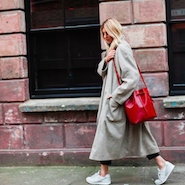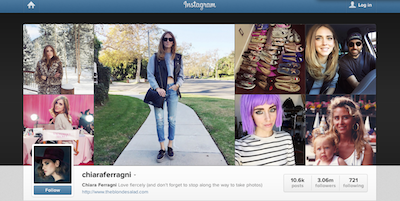 Blogger Camille Charriere for Bergdorf Goodman
Blogger Camille Charriere for Bergdorf Goodman
Influencers today yield more power than celebrities to shape consumer opinion, presenting an opportunity for brands to reach their legions of followers through a trusted voice, according to a new report by Fashionbi. “Fashion Influencer Marketing: Creating Successful Brand Collaborations with Fashion Bloggers in 2016” says that while traditional fashion imagery may seem unattainable to the average consumer, bloggers and social media stars can make fashion appear more attainable. Influencers can boost the ROI on marketing campaigns with the right strategic approach to a partnership, which requires a mix of control over the project and freedom to let the influencers be creators themselves.
"The landscape of influencer marketing is changing and how," said Ambika Zutshi, CEO of Fashionbi. "While before, the brands had an upper edge and could lure the influencers with gifts and such, today, the influencers are taking full interest and offering brainstorming session to develop a campaign idea and execution with the brands.
"They are not just the executors but also the creators," she said. "They know their audiences and the content they are going to like. They know what goes with their brand image and can reject a collaboration purely based on these factors.
"From the brands' side, today, there are multiple tools such as Fashionbi, Tapinfluence, Traackr, Instabrand, etc., that can give real-time statements to the brands about an influencer's activity. Hence, the scope of doing mistakes or reaching the wrong audience is diminished."
Brand representative Influencers have become big business themselves, with many bloggers now represented by agencies. The selection process needs to be more intricate than selecting the blogger with the most followers. To find a genuine fit likely to yield results, brands should look at who an influencer’s followers are, checking to see if they align with the label’s target customer. It is also important for brands to look into what platforms their audience engages with and pick a corresponding influencer. Along with the rise in audience and engagement on platforms such as YouTube, Instagram and Snapchat, bloggers’ roles have shifted from written to visual mediums. Chiara Ferragni
Instagram, a popular choice for Louis Vuitton and Saint Laurent, has 200 million users, with most between the ages of 18 and 29. A top choice for Instagram may be The Blonde Salad’s Chiara Ferragni. Brands going after a different demographic, for instance the 26 to 35 crowd, might want to pick a different platform, such as Pinterest.
When working on a platform-specific campaign, brands should be aware that consumers will start their search on that social network. It is therefore a best practice for the label to also have a strong presence on the platform.
Beyond finding a platform and audience match, brands should conduct research into who the influencer is, including what other labels they have promoted and how they represent themselves. Even if a brand is enamored with a certain influencer, it is more important that the influencer is a fan of the brand.
Before any content is created or the influencer is compensated, brands need to set specific terms of the agreement, laying out what is expected from the collaboration. After that, communication is key, and the influencer should be provided with all the information they need to accurately represent the brand.
Chiara Ferragni
Instagram, a popular choice for Louis Vuitton and Saint Laurent, has 200 million users, with most between the ages of 18 and 29. A top choice for Instagram may be The Blonde Salad’s Chiara Ferragni. Brands going after a different demographic, for instance the 26 to 35 crowd, might want to pick a different platform, such as Pinterest.
When working on a platform-specific campaign, brands should be aware that consumers will start their search on that social network. It is therefore a best practice for the label to also have a strong presence on the platform.
Beyond finding a platform and audience match, brands should conduct research into who the influencer is, including what other labels they have promoted and how they represent themselves. Even if a brand is enamored with a certain influencer, it is more important that the influencer is a fan of the brand.
Before any content is created or the influencer is compensated, brands need to set specific terms of the agreement, laying out what is expected from the collaboration. After that, communication is key, and the influencer should be provided with all the information they need to accurately represent the brand.
 Peace Love Shea for Gucci
Campaigns that tell some kind of story, whether around a product or service, are the most effective, partially because the influencer will be more inclined to want to share the content. Keeping a human element and getting away from a simple product focus, the blogger can then share a story about who they are as a person as it relates to the brand.
In order to accurately measure the efficacy of the campaign, it is important to first identify the specific goals of the project, which will usually come down to awareness or engagement. In addition to looking at their own metrics, brands can request insights from their influencers’ social feeds to get a better picture.
For awareness, a brand might look at KPIs such as volume, reach or exposure, while engagement would revolve around number of retweets, comments, replies or participation.
Brands may also want to look at traffic driven to their Web site and subsequent sales. For those looking to build advocacy, it may also be wise to track the influence of each contributor to the campaign.
Peace Love Shea for Gucci
Campaigns that tell some kind of story, whether around a product or service, are the most effective, partially because the influencer will be more inclined to want to share the content. Keeping a human element and getting away from a simple product focus, the blogger can then share a story about who they are as a person as it relates to the brand.
In order to accurately measure the efficacy of the campaign, it is important to first identify the specific goals of the project, which will usually come down to awareness or engagement. In addition to looking at their own metrics, brands can request insights from their influencers’ social feeds to get a better picture.
For awareness, a brand might look at KPIs such as volume, reach or exposure, while engagement would revolve around number of retweets, comments, replies or participation.
Brands may also want to look at traffic driven to their Web site and subsequent sales. For those looking to build advocacy, it may also be wise to track the influence of each contributor to the campaign.
 Aimee Song for Tod's
Aimee Song for Tod's
"A brand's reputation can be instantly destroyed with the wrong communication to the wrong audience," Ms. Zutshi said. "Hence, it is a must that a brand has full control on the project, whilst being flexible and open to hear the influencer's own opinion.
"The most basic way to ensure this is to ask the analytics access to the influencer's blog or Web site," she said. "This could be Google Analytics for his Web site or the backend access to his Twitter account.
"Then, there are many other tools prevailing in the market today that can help a brand/influencer identify and understand their audience, monitor the reach of each post made on via social media account and how the audience engage on a certain content and what they say. Audience reach can be a crucial indicator in understanding the awareness of a campaign, however, their perception is what directly proportionates to the brand's reputation.
"With Google Analytics, a brand can then even further monitor the visitors path coming from an influencer's post and see if those visitors converted as the brand's buyers - if that's the campaign goal, that is."
Influencing the influencers Beyond sponsored content, there are other ways to build relationships with key social influencers. Inviting them to special events will likely result in photos and posts documenting the party. Gifting can also be an effective choice if a brand can afford it, and will usually receive a thank you note in the form of a social post. However, gifts should be catered to the individual’s personal style to raise the likelihood of a positive response. Exclusive giveaways, discount codes or gifts with purchase for a particular influencer’s audience are other ways to connect. Harrods Digital Style Summit
Harrods Digital Style Summit
For instance, British department store Harrods brought together eight fashion taste makers for a photo shoot in London as part of its first Digital Fashion Summit.
In addition to acting as models, the bloggers created content for the retailer in the form of top five lists of their must-have spring items. Having these bloggers participates creates a form of brand endorsement, both for Harrods and the labels featured in the digital content created (see story).
Social media is becoming more easily monetized, with a number of platforms including Pinterest creating buy buttons and start-ups working on tagging-enabled video. YouTube is becoming very crowded, but Facebook’s video upgrades are promising and consumers’ short attention spans are a good fit for Vine’s six second format. Eighty percent of consumers are more apt to convert after watching a video, and the average click-through to purchase rate on clickable video is 25 percent.Since fashion bloggers arrived on the scene about a decade ago, they have gained influence and grown to be leaders in the industry, said an earlier report by Fashionbi.
As these bloggers gained an audience, brands began to partner with them for advertising campaigns, events and other marketing efforts. While it may seem that fashion bloggers are losing their luster, they still have large followings that can rival magazines, creating an opportunity for luxury brands to reach a large, fashion-focused audience (see story).
"There are multiple factors to take into consideration, in order to get a 200 percent return out of a collaboration," Ms. Zutshi said. "As stated in the Fashionbi's Marketing Research, Fashion Influencer Marketing in 2016, the first thing for a brand is to define its target audience.
"Then comes the part of the research where the brand can no longer go with the 'trending celebrity' but with the one that is coherent with the brand's image and is popular on the channels a brand wants to target," she said. "This part also includes making a research about the advertising laws in the country they want to target to make sure you adhere with them.
"Establishing a campaign goal is the next step, followed by defining the big picture for the fashion campaign. This includes an influencers knowing all about your brand and reputation and participates in formulating an effective storytelling.
"And then, as the campaign goes, it is utmost important to measure the analytics in real time and tuning or changing the strategy according to the sentiments of the target audience (hence, having a ready Plan B is ideal). Lastly, a post event analysis check to analyze all the wrongs and rectify them in the next campaign is a key."
Final Take Sarah Jones, staff reporter on Luxury Daily, New York
